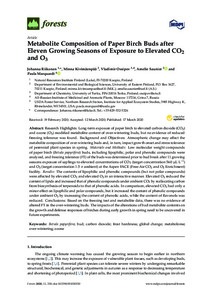Metabolite Composition of Paper Birch Buds after Eleven Growing Seasons of Exposure to Elevated CO2 and O-3
Minna Kivimäenpää; Paula Marquardt; Johanna Riikonen; Amelie Saunier; Vladimir Ossipov
Metabolite Composition of Paper Birch Buds after Eleven Growing Seasons of Exposure to Elevated CO2 and O-3
Minna Kivimäenpää
Paula Marquardt
Johanna Riikonen
Amelie Saunier
Vladimir Ossipov
MDPI
Julkaisun pysyvä osoite on:
https://urn.fi/URN:NBN:fi-fe2021042822899
https://urn.fi/URN:NBN:fi-fe2021042822899
Tiivistelmä
Research Highlights: Long-term exposure of paper birch to elevated carbon dioxide (CO2) and ozone (O-3) modified metabolite content of over-wintering buds, but no evidence of reduced freezing tolerance was found.
Background and Objectives: Atmospheric change may affect the metabolite composition of over-wintering buds and, in turn, impact growth onset and stress tolerance of perennial plant species in spring.
Materials and Methods: Low molecular weight compounds of paper birch (Betula papyrifera) buds, including lipophilic, polar and phenolic compounds were analyzed, and freezing tolerance (FT) of the buds was determined prior to bud break after 11 growing seasons exposure of saplings to elevated concentrations of CO2 (target concentration 560 mu L L-1) and O-3 (target concentration 1.5 x ambient) at the Aspen FACE (Free-Air CO2 and O-3 Enrichment) facility.
Results: The contents of lipophilic and phenolic compounds (but not polar compounds) were affected by elevated CO2 and elevated O-3 in an interactive manner. Elevated O-3 reduced the content of lipids and increased that of phenolic compounds under ambient CO2 by reallocating carbon from biosynthesis of terpenoids to that of phenolic acids. In comparison, elevated CO2 had only a minor effect on lipophilic and polar compounds, but it increased the content of phenolic compounds under ambient O-3 by increasing the content of phenolic acids, while the content of flavonols was reduced.
Conclusions: Based on the freezing test and metabolite data, there was no evidence of altered FT in the over-wintering buds. The impacts of the alterations of bud metabolite contents on the growth and defense responses of birches during early growth in spring need to be uncovered in future experiments.
Kokoelmat
- Rinnakkaistallenteet [19207]
